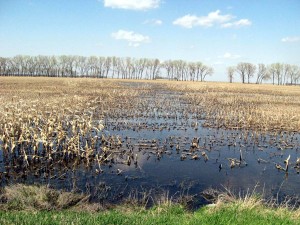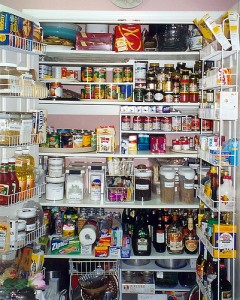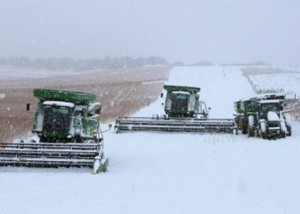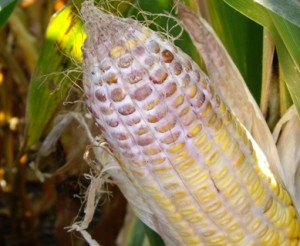Ok folks. Here’s some more info on food shortage—it’s going to be a wet year for crops. I keep getting flack for putting food shortage information out there and have been called a fear monger and irresponsible journalist. But the fact of the matter is, we do need to be aware of these kinds of things so that we can knowledgably address our preparedness needs.
In an effort to allay fears of citizens, the USDA has issued several statements this year celebrating a “bumper crop” outlook among farmers. In some key farming areas, a late crop was planted due to weather complications. However, due to heavy rains nationwide, early frosts and snow, many farmers are reporting a very different scenario.
Corn and bean crops all over the farming regions of the U.S. are soaked. It’s a wet year for crops. I’ve read over 30 accounts from farmers who can’t even get a combine out in the field due to the rain or snow. Those who are able to harvest are having a tough time drying the corn and a great deal of the corn is moldy. Some beans have begun to pop weeks early. There have been bumper crops grown, but no way to harvest them with all of the moisture and subsequent freezing weather.
Wheat farmers are conveying the same message as well. “It’s as if the harvest time came and went like a thief in the night,” says one farmer from South Dakota. Some farmers have resorted to chisel plowing, but it’s slow going and with additional threats of moisture and freezing temperatures, it doesn’t look good. Some of the hot September days helped late planted crops to mature, but the harvesting of such crops is still a challenge.
Check out these statistics in regards to our crops
- According to Texas AgriLife Personnel, Texas wheat crops were subjected to heavy rains followed by army worms. As such the crop yields are diminishing greatly.
- South Central Kansas is concerned about even getting their winter wheat planted due to the excessive moisture in the ground at present.
- North Texas claims that there has been over 2 feet of rain in the last 2 months and as a result, the cotton will never be harvested.
- Redwood County, MN reports that only 50% of the soybeans were harvested and has now “ground to a halt.” Their growing season has ended with 5 nights in a row in the mid 20’s.

Wright County, IA awoke to an inch of snow on the ground earlier this month. One farmer claimed “Harvest at a standstill after this snow. I think the speculators are in for a big surprise by the time harvest ever gets on the way or done.”
- A Northern Indiana farmer says “We have not been able to even get into a field to harvest and weather has only let us plant 20 acres of wheat, the corn is running 28% and bean stems are still green. I think they should rethink the harvest outlooks, can't see it being a bumper anything...with a chance of early snow.”
- A Brown County, SD farmer had this to report, “Haven't turned a wheel yet for harvest. Approaching 13 inches of rain for September and early October and now it is snowing. Gonna be an interesting harvest if we even are able to get in the field.”
Action you should take because of crops shortage:
 My point? Because of this wet year for crops, don’t plan on our reserves being filled again any time soon folks. You should also plan on steep price increases beginning the first part of November due to the low yields. These price increases will be most evident on items which contain corn or corn derivatives. And keep an eye out for anything which contains soy increasing dramatically as well. With the problem being on such a national level, it’s bound to affect the market dramatically as opposed to a little “blip” that would occur if the lack of crops were isolated to one area. During this wet year for crops, my advice to you is to store up, folks, so that you can afford your other necessities.
My point? Because of this wet year for crops, don’t plan on our reserves being filled again any time soon folks. You should also plan on steep price increases beginning the first part of November due to the low yields. These price increases will be most evident on items which contain corn or corn derivatives. And keep an eye out for anything which contains soy increasing dramatically as well. With the problem being on such a national level, it’s bound to affect the market dramatically as opposed to a little “blip” that would occur if the lack of crops were isolated to one area. During this wet year for crops, my advice to you is to store up, folks, so that you can afford your other necessities.
Category:
© 2019 Of COURSE this post is Copyright Protected by Preparedness Pro. All Rights Reserved. NO portion of this article may be reposted, printed, copied, disbursed, etc. without first receiving written permission by the author. This content may be printed for personal use only. (Then again, laws are only as good as the people who keep them.) Preparedness Pro will pursue all violations of these rights just as vigorously as she does any of her other freedoms, liberties, and protections.




Comments
Great..
My advice to myself.. Try and buy a couple barrels with locking lids this weekend and pick up several hundred pounds of corn and wheat. I have mentioned the feed store before. It is my understand in PA that the wheat should not be treated with anything unless it is "seed" grain. It is not the cleanest, dust and weed heads in it. Not that bad though concidering the cost savings.
This is not surprising. We started a garden this year and only got three ripe tomatoes out of a dozen plants. Those three got so blighted that they were inedible. Same with the corn. Not one ear of our 20 plants reached maturity. We got a couple handfuls of beans and some carrots and not much else. I would chalk it up to inexperience, but several very experienced gardneers in the area have reported similar results.
We can bail out the banks and the car companies by printing more money. I don't think the government has the ability to print food.
Now you’re seeing it, Joe. Food, not money feeds folks. That’s why Food is a higher priority in what I teach than financial preparedness is.
Wow, Joe -- well said! "We can bail out the banks and the car companies by printing more money. I don't think the government has the ability to print food."
I too am worried about the cost of food going up. I am new to this and worry that I will not have time to stock food before I simply cannot afford to buy extra. I am afraid that I will only have enough to buy just what I am using and not enough extra to put back.
Action goes a long way in allaying fears.
Well I thought the same way. I am on a fixed income and get no other assistance. But I knew that my power was going up in the winter so I needed to plan for that. So I started out getting my power as low as possible, putting everything on power strips and turning them off at the strip. I bet I saved about $5.00-10.00 per month doing that and I live in a "cheap power" state. A big thing is getting back into scratch cooking. Bread costs on average $1.-$2.00 per loaf you can make it for about .25 cents a loaf and that's only 1 example. You will need to use more of your time in place of money. Take a look at your budget. keep a notepad with you at all times and write down everything you spend for a month. You might be surprised how much you spend on food and stuff.
They are a lot of ways to save money here if you go back through the older entries.
My Basic List for Prep Start
50# bag of rice $17.00
50# bag of Pinto’s $25.00
50 # White Flour $15.00
10# bag Sugar $5.00 More if you have a sweet tooth/baking coffee,teas or make your own candies
Powder milk Lg Box $18.00
Honey, Real 5# $12-17.00 Great multi-tasker
Yeast 1# $2-5.00 Starter for sourdoughs and gets you going for baking breads, donuts
Salt 4# $5.00 Kosher,iodized, and Pickling
Now for about $100.00 you have a good start. No, it’s not perfect but it will give you a basis to build on without breaking the bank. Plus this can be broken down into several shopping trips. All of those prices are average not sale prices.
here in the socialist republic of wiscosnin we have really wierd weather all year, cold, then hot then no rain and now rain rain rain.......I see many farmers who have not even begun to harvest thier corn or soybeans. The fields are too wet.
What bothers me is that people call you irresponsible for telling the truth?.. Must be Lame stream media folfs...
We live in eastern Nebraska and very little of the crops are out in our area. We have had rain, cold, freezing temps, etc., after having one of the wettest, coldest summers. We have raised a commercial garden for several years and had the worst garden ever, had trouble getting hay up properly. One thing about this weather is that the crops have trouble drying down, which if you can get them out means they have to be put in drying bins and dried down (with expensive electricity and propane) and these new hybrids put everything into the corn not the stalk (like the old varieties did). This means that the corn that is out there is going to start falling off of the stalks onto the ground probably before it can be harvested. I agree with your assessment of food shortages. And yet the big companies keep sending our reserves overseas. Everyone here is extremely anxious.
We have had a wet, cool summer in KS. I just bought a 100 lbs of corn and wheat from a
farmer friend. Getting ready to can pinto beans for the storage room. I keep canning
and buying. Thank you. Your site is great.
This should be good time to get your meat. Pork is at a low price because of the "Swine Flu". Beef will probably go down as folks slaughter early to save on grain/feed costs.
Thanks for keeping us informed.
I looked up how to do eggs but the link would not come up so my question is do you let the eggs get to room temp and then just dip them in the warm oil or brush it on. Does it dry fast while you are holding it ....do not want it to come off when put in carton.....
thanks
Jackie
Kellene,
Keep doing your 'prep pro'. you are helping and inspiring many people to do the right thing. do not let the 'ostriches' put you down... they may come and knock on your door when the 'perfect storm' hits....:)
I discovered your site about a month ago and it has been a God sent library of information.
the fields in front of my little house {central Illinois) have still acres of corn hoping to be harvested. the soybeans were done about 10 days ago - between 2 storms....it has been raining for 2 days now - it stopped a little today....
I am a senior that does not have transportation and friends and family do not understand ' my compulsion' in canning, getting ready...etc. I wish I could find someone to go shopping without having to justifying the quantities I would like to get...:)- I' ll keep going on.... I will be as ready as I can when bad weather hit the area.
Thanks again for your efforts and the information provided.
This is very worrisome. I have been working on storage and preparedness for a long time, but, I keep having this feeling that time is very short, and we need to get as much as possible as fast as possible. There are just too many bad signs. I don't know how much time we have before the bottom falls out. And this is just if nothing else happens----which most likely something will.
What is your opinion?
I say that feelings such as yours are worth listening too and are worth more than any information you can get on a blog, watching the news etc. Just be sure that you aren’t heeding to any feelings of panic of fear. Those do not come from a Reliable Source.
I suppose at this point in my understanding I should expect everything we are told to be a lie or half truth. I actually thought we ended up having a bumper crop this year. Which seemed shocking to me given all the bad stuff I heard early on in the season. Now we hear things like that which completely contradict what "they" are telling us.
Honestly it is no wonder no one prepares, it is hard enough just to figure out what the truth is. Plus around here there was good harvests and plenty planted.
On top of all that you are asking people to prepare for somethign that is unimaginable. We have never before witnessed a complete breakdown of our society or food supply, most folks think it is impossible. To them it is as likely as little monsters coming out of the sea and taking over the earth.. In otherwords, not gonna happen.
Well, Todd. Can’t argue with you there. It is hard to prepare for the unimaginable. But then again, that’s why I don’t just rely on what I “see” and “hear”. That’s why spiritual preparedness is the most important part of preparedness. You’ve got to the get the truth from somewhere.
A devout Catholic in Oregon, I have had a strong desire to start preparing, especially canning and preserving food, since this July. WAY above and beyond my normal levels, including canning beans and meats for protein...and have been compulsively reading food storage sites for several months. Water is stored in the basement, the root cellar is full from the garden...am probably up to the 6 month level overall, some areas are at one year, still light on dairy/cheese but that means on-line purchases so I have to budget carefully. I closed a savings account and spent it on food storage. My old crummy van is paid off, it needs a new power steering pump, but I'd rather spend the money on prepping.
I work in county government, and usually just ignored the information from our Emergency Preparedness person...until this summer, when I just couldn't get enough information and really started listening and acting on the material. I have been reading prepping and survivalist websites, and putting together a file. Most importantly, I have been praying for guidance and studying the Scriptures about preparedness, especially Proverbs, and the story of Joseph.
Two strong Christian friends of mine have been feeling frustrated with the lack of spiritual growth in our area, and how they feel like they have been learning and training for years. I spoke to the Lord about it, "Oh Lord, they are strong believers, they live for You, haven't they been trained enough?" and His word back was "NOT FOR WHAT IS NEXT"
One website I saw mentioned that if you were called to prepare, the Lord is looking out for you and providing for you in His mercy. Follow His leadings, be like the ant storing up during the harvest...be wise, forsee danger and hide from it. Trust in the Lord with all your heart, don't let fear and panic be a part of this time of preparing, and yes, store extra and be ready to share.
Warm? like over room temp?
Jackie I did this for the first time and got a 16 oz bottle of mineral oil. Poured it in a small bowl thinking I'd have to dip them or something.
Gloves are defiantly the way to do it.
Silly me for trying to make it harder than it needed to be.
I will be restocking this November. I did Kellene's Challenge this month and did notice a few things to work on
I am ordering the cheese wax and will be doing around 10 pounds of cheese.
More eggs when they go on sale.
Freeze dried vegies for suops and stews.
More meats cured and Smoked. I did some pickled pork, it turned out ok, but not something I liked enough to invest all that time in again for the results I got. I think it was just a matter of taste not process. Can't wait until we get canned bacon recipe.
More Goodies vacuumed sealed. Was about a week short of what I expected I needed.
A few more prepared foods or easy to cook items. I was sick for about 2 weeks and found that I went for the quick to cook items instead of using the beans, rice and flour to make meals. I have to assume this will happen in a disaster so I need those items on hand. If it took more than 5 minutes to cook I just wasn't interested.
Just part and parcel of my condition and stress is very hard on me so I will need to rethink how I do some prep stuff.
Warm, like in the microwave. Not too hot to the touch of course. It goes further when it’s warm and is just as effective.
thanks, was a bit worried so just warm to the touch. I was so surprised how far a little bit of mineral oil went.
I know you have your favorites Kellene and that your Maceys has online order/specialty order. That can be shipped to home address. I am not finding any of the freeze-dried goods on the online shopping catalog. Not sure if I am missing it or if they need to offer it.
Just asking
I do have a couple of online stores that you can get stuff if anyone is interested. Shoot me an email
Remember it's still shopping you have to take in account cost vs. quality vs. quantity. Plus shop around, no one is good at everything. You may do better at your local big box store or restaurant supply store.
I saw one site offering 30 days of food for 1 person for over $300.00 USD. Heck for that I could do a years worth of food for 2 people and still have money left over for ammo. I am sure Kellene could better that. I am cheap, She is thorough.
When you see deals like that, Jamie, be sure to check caloric content as well. I’ve seen the buckets of food at Costco that don’t have sufficient calories in them to keep a person alive and yet they are sold as long term food supplies.
Agreed I was angry at a 1 of my online suppliers. I bet you can guess whom. About some insane price for 1 person for 30 days. No I do better following your advice. Now if there is a sale that is worthwhile I'll get it. But will I buy the "Kits" no way just a rip off as far as I am concerned.
$310.00 for prepping1 person for 30 days, man can you imagine what we could do with that much money?
I know you have your favorites Kellene and that your Maceys has online order/specialty order. That can be shipped to home address. I am not finding any of the freeze-dried goods on the online shopping catalog. Not sure if I am missing it or if they need to offer it.
Jamie, I don’t see the Blue Chip stuff available online at Macey’s either. However, I wouldn’t rule it out. Try calling them. Otherwise you’ll have to deal directly with Blue Chip.
Yeah I think I'll call and ask about being made available online. They'd do some killer sales.
Good looking out.